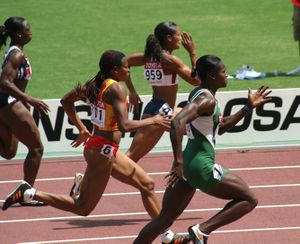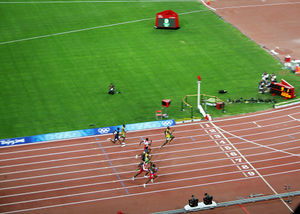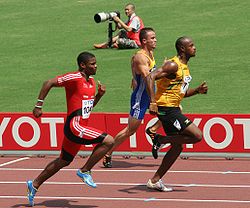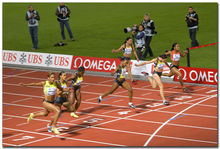100 metres

100 m (one hundred metres) is the shortest outdoor sprint race distance in the sport of athletics. The reigning 100 m Olympic champion is often named "the fastest man/woman in the world". The 200 m record has often been at a faster average speed than the 100 m record.
Sprinters typically reach top speed after somewhere between 50–60 m. Their speed then slows progressively towards the finish line. Maintaining that top speed for as long as possible is a primary focus of training for the 100 m.[1]
In the past, athletes in Anglophone countries often competed over 100 yards (91.4 m) instead of 100 m, especially in the United States. This shorter distance is now obsolete. Indoor sprints are often run over 60 m (sometimes 50 m or 55 m) as few facilities have a 100 m indoor straight.
On an outdoor 400 metres running track, the 100 m is run on the home straight, the start being set on an extension to make it a straight-line race.
Contents |
Record performances
Major 100 m races, such as at the Olympic Games, attract much attention, particularly when the world record is thought to be within reach.

The men's world record has been improved upon twelve times since the introduction of electronic timing in 1968. The current men's world record of 9.58 s is held by Usain Bolt of Jamaica, set at the 2009 World Athletics Championships final on 16 August 2009, breaking his own previous world record by 0.11 s.[2] The current women's world record of 10.49 s was set by Florence Griffith-Joyner of the USA, in Indianapolis, Indiana, on 16 July 1988.[3]
Illegal drug use has been seen by some people as a means to gain a competitive edge; in particular, the scandal at the 1988 Summer Olympics when the winner Ben Johnson was stripped of his medal. In 2003, revelations of failed drug tests by sprinting legend Carl Lewis before the 1988 Seoul Olympics also put the validity of his achievements into question.[4]
Jim Hines was the first man to break the 10-second barrier in the 100 m, recording the first sub-10 second, electronically timed run to win the 100 metres at the 1968 Olympics.
Start
At the start, some athletes play psychological games such as trying to be last to the starting blocks, although direct intimidation would be considered unsportsmanlike. The starter will keep the sprinters in the set position for an unpredictable time of around two seconds and then fire the starting gun.
The time between the gun and first kick against the starting block is measured electronically, via sensors built in the gun and the blocks. A reaction time less than 0.1 s is considered a false start. The 0.1-second interval accounts for the sum of the time it takes for the sound of the starter's pistol to reach the runners' ears, and the time it takes to react to it.

For many years a sprinter was disqualified if responsible for two false starts individually. However, this rule allowed some major races to be restarted so many times that the sprinters started to lose focus. The current rule, introduced in February 2003, is that, after one false start, anyone responsible for a subsequent false start is disqualified immediately. This rule has led to some sprinters deliberately false-starting to gain a psychological advantage: an individual with a slower reaction time might false-start, forcing the faster starters to wait and be sure of hearing the gun for the subsequent start, thereby losing some of their advantage. In order to avoid such abuse, the IAAF will implement a change to the rule from the 2010 season, so that the first false starting athlete is immediately disqualified.[5] This proposal was met with objections when first raised in 2005, on the grounds that it would not leave any room for innocent mistakes. Justin Gatlin commented, "Just a flinch or a leg cramp could cost you a year's worth of work."[6].
Finish
The winner is determined by the first athlete with his or her torso (not including limbs, head, or neck) over the nearer edge of the finish line.[7]
Climatic conditions

Climatic conditions are a crucial factor for good performances in the 100 m. Air resistance is the primary climatic factor in sprint performances. A strong head wind is very detrimental to performance, while a tail wind can improve performances significantly. For this reason, a maximum tail wind of 2.0 m/s is allowed for a 100 m performance to be considered eligible for records, or "wind legal".
Furthermore, sprint athletes perform better at high altitudes because of the thinner air, which provides less air resistance. In theory, the thinner air would also make breathing slightly more difficult (due to the partial pressure of oxygen being lower), but this difference is negligible for sprint distances where all the oxygen needed for the short dash is already in the muscles and bloodstream when the race starts. While there are no limitations on altitude, performances made at altitudes greater than 1000 m above sea level are marked with an "A".[8]
Fastest 100 metres runners
Top ten all-time athletes—men
Updated 29 August 2010[2]
| Rank | Fastest time | Wind (m/s) | Athlete | Country | Date | Location |
|---|---|---|---|---|---|---|
| 1 | 9.58 | +0.9 | Usain Bolt | 16 August 2009 | Berlin | |
| 2 | 9.69 | +2.0 | Tyson Gay | 20 September 2009 | Shanghai | |
| 3 | 9.72 | +0.2 | Asafa Powell | 2 September 2008 | Lausanne | |
| 4 | 9.78 | +0.9 | Nesta Carter | 29 August 2010 | Rieti | |
| 5 | 9.79 | +0.1 | Maurice Greene | 16 June 1999 | Athens | |
| 6 | 9.84 | +0.7 | Donovan Bailey | 27 July 1996 | Atlanta | |
| +0.2 | Bruny Surin | 22 August 1999 | Seville | |||
| 8 | 9.85 | +1.2 | Leroy Burrell | 6 July 1994 | Lausanne | |
| +0.6 | Justin Gatlin | 22 August 2004 | Athens | |||
| +1.7 | Olusoji Fasuba | 12 May 2006 | Doha |
Notes
- Tyson Gay also has a time of 9.68 s set on 29 June 2008 during the 2008 U.S. Olympic Track & Field Trials at Hayward Field in Eugene, Oregon; the tail wind speed was 4.1 m/s, more than double the IAAF legal limit.[9]
- Obadele Thompson ran a wind-aided 9.69 in El Paso, Texas in April 1996 which stood as the fastest ever 100m time for 12 years until Tyson Gay's June 2008 performance
- Justin Gatlin ran 9.77 in Doha on 12 May 2006, which was at the time ratified as a world record. However, the performance was annulled in 2007 after he failed a doping test in April 2006.
- Carl Lewis ran a time of 9.78 seconds at the 1988 US olympic trials in Indianapolis but it was wind aided.
- Tim Montgomery's time (9.78 at Paris on 14 September 2002) was invalidated following his indictment in the BALCO scandal on drug use and drug trafficking charges. The time had stood as the world record until Asafa Powell first ran 9.77.
- Ben Johnson ran 9.79 at Seoul on 24 September 1988, but he was disqualified after he tested positive for stanozolol after the race. He subsequently admitted to drug use between 1981 and 1988, and his time of 9.83 at Rome on 30 August 1987 was invalidated. Carl Lewis's 9.92 in the Seoul race was therefore recognized as the world record, and his two prior runs of 9.93 were seen as having equalled the previous world record.
Top ten all-time athletes—women

Updated 20 September 2009
| Rank | Fastest time | Wind (m/s) | Athlete | Nation | Date | Location |
|---|---|---|---|---|---|---|
| 1 | 10.49 | 0.0 | Florence Griffith-Joyner | 16 July 1988 | Indianapolis | |
| 2 | 10.64 | +1.2 | Carmelita Jeter | 20 September 2009 | Shanghai | |
| 3 | 10.65 [A] | +1.1 | Marion Jones | 12 September 1998 | Johannesburg | |
| 4 | 10.73 | +0.1 | Shelly-Ann Fraser | 17 August 2009 | Berlin | |
| +2.0 | Christine Arron | 19 August 1998 | Budapest | |||
| 6 | 10.74 | +1.3 | Merlene Ottey | 7 September 1996 | Milan | |
| 7 | 10.75 | +0.4 | Kerron Stewart | 10 July 2009 | Rome | |
| 8 | 10.76 | +1.7 | Evelyn Ashford | 22 August 1984 | Zürich | |
| 9 | 10.77 | +0.9 | Irina Privalova | 6 July 1994 | Lausanne | |
| +0.7 | Ivet Lalova | 19 June 2004 | Plovdiv |
Notes
- Florence Griffith-Joyner's World Record has been the subject of a controversy due to strong suspicion of a defective anemometer measuring a tailwind lower than actually present; since 1997 the International Athletics Annual of the Association of Track and Field Statisticians has listed this performance as "probably strongly wind assisted, but recognised as a world record".[10]
- Marion Jones later confessed to using performance enhancing drugs in setting her 100m time.
Area records
Updated 21 September 2009.[11]
| Area | Men's | Women's | ||||
|---|---|---|---|---|---|---|
| Time | Athlete | Nation | Time | Athlete | Nation | |
| Africa (records) | 9.85 | Olusoji Fasuba | 10.90 | Glory Alozie | ||
| Asia (records) | 9.99 | Samuel Francis | 10.79 | Li Xuemei | ||
| Europe (records) | 9.86 | Francis Obikwelu | 10.73 | Christine Arron | ||
| North, Central America and Caribbean (records) |
9.58 WR | Usain Bolt | 10.49 WR | Florence Griffith-Joyner | ||
| Oceania (records) | 9.93 | Patrick Johnson | 11.12[A] | Melinda Gainsford-Taylor | ||
| South America (records) | 10.00[A] | Robson da Silva | 11.17[A] | Lucimar Aparecida de Moura | ||
Notes
- A Represents a time set at a high altitude.[12]
- WR World Record
See also
- 100-yard dash
- National champions 100 metres (men)
- World record progression 100 metres men
- World record progression 100 metres women
References
- ↑ http://speedendurance.com/2008/08/22/usain-bolt-100m-10-meter-splits-and-speed-endurance/
- ↑ 2.0 2.1 "Top List - 100m". IAAF. http://www.iaaf.org/statistics/toplists/inout=O/age=N/season=0/sex=M/all=y/legal=A/disc=100/detail.htmx. Retrieved 2008-09-02.
- ↑ 100 Metres All Time. IAAF (2009-03-09). Retrieved on 2009-05-06. Archived 2009-05-08.
- ↑ MacKay, Duncan (24 April 2003). "'Who cares I failed drug test?'". London: Guardian. http://www.guardian.co.uk/sport/2003/apr/24/athletics.duncanmackay. Retrieved 2008-09-06.
- ↑ "IAAF keeps one false-start rule". BBC. 2005-08-03. http://news.bbc.co.uk/sport2/hi/athletics/4433815.stm. Retrieved 2008-08-15.
- ↑ "Gatlin queries false start change". BBC News. 2005-05-06. http://news.bbc.co.uk/sport2/hi/athletics/4521963.stm. Retrieved 2008-08-15.
- ↑ Sandre-Tom. "IAAF Competition Rules 2009, Rule 164". IAAF. Archived from the original on 2009-09-03. http://www.webcitation.org/5jWCCLDoE. Retrieved 2009-08-23.
- ↑ 100 metres IAAF
- ↑ Zinser, Lynn (30 June 2008), "Shattering Limits on the Track, and in the Pool" The New York Times
- ↑ Linthorne, Nick (March 2003). "Wind Assistance". Brunel University. Archived from the original on 2009-09-03. http://www.webcitation.org/5jWCChh5E. Retrieved 2008-08-25.
- ↑ 100 metres records. IAAF (2009-04-09). Retrieved on 2009-04-09. Archived 2009-04-26.
- ↑ 60 Metres Records. IAAF (2009-04-04). Retrieved on 2009-04-04.
External links
|
|||||||||||||||||||||||||||||||||||||||